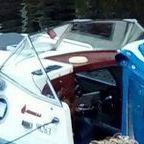Had two GRP cruisers both made in the seventies with no sign of osmosis on either.
Perusing other boaty forums, it seems to be a rare occurance but takes the form of 'bubbles' in the gel coat.The repair seems to be cutting these 'bubbles' off, allowing the hull to dry out and use gel coat filler, sand and paint. General opinion has it that these 'bubbles'are caused by poor build quality control, possibly moisture in the initial layup.Scratches in the gelcoat if untreated can cause osmosis by allowing water into the fibreglass, and if a large enough area, can weaken the structure.
Had two GRP cruisers and a steel narrowboat so am giving my opinion.
I cruise singlehanded so that has coloured my opinion.
In the GRP boat, you moor at the lock landing, climb out, set the lock, back to the boat, climb in, into the lock, climb out, fill or empty the lock, climb in, out of the lock, climb out, close lock gates, back to the boat and climb in.
This is fine for the first dozen or so locks, but does become quite fatiguing.I did have 'mounting blocks' but it was still necessary to step up and down.
The narrowboat was much easier in that you only needed to step on and off.
The other reason I thought the steel narrowboat was a better vehicle for narrow canals (apart from them usually being better equipped with creature comforts) was the handling.
All boats are of course affected by wind, but the GRP boats being more on the water than in it, and light weight for their size, in windy conditions you couldn't take your attention off the steering for long as they tend to wander.The narrowboat, once underway was much more directionally stable due to it's weight and deeper draught.





